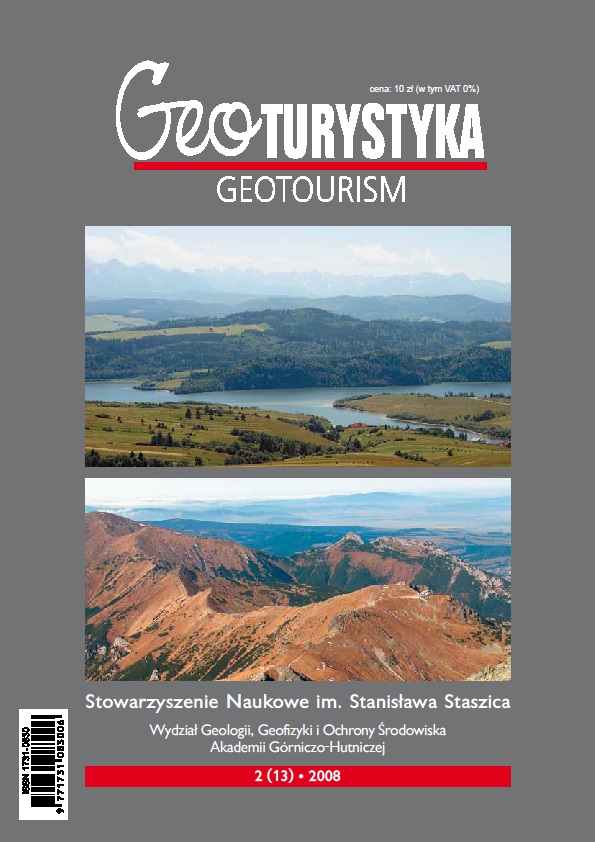The Tatras – nappes and landscapes
DOI:
https://doi.org/10.7494/geotour.2008.13.75Słowa kluczowe:
thrust, nappe, trough, semihorst, Tatra Mts, Carpathians, płaszczowina, nasunięcie, zapadlisko, półzrąb, Tatry, KarpatyAbstrakt
Geological structure of the Tatra Mts is a result of long-lasting processes. The key nappes have already been completed some 65 Ma ago. However as a mountain range the Tatras has emerged at the surface only 5 Ma ago, when a piece of continental crust separated from African continent at the beginning of Mesozoic era ultimately collided with Europe. Thus, the crystalline core of the Tatras, which builts also the highest crest is a fragment of Africa. This monumental mountains are, however, not an effect of the overthrusting but they resulted from young, vertical tectonic movements, which are still active and which sometimes shake the whole Podhale region. The following paper explains how the Tatras were formed. The figures enclosed illustrate the succeeding formation stages of the mountain range and the photographs allow the Reader to compare drawings with the field. Welcome to the Tatras.
//
Struktura geologiczna Tatr formowała się bardzo długo, a kluczowe dla niej płaszczowiny były już gotowe przed 65 milionami lat. Pomimo tego jako góry Tatry zaczęły się wyraźnie zaznaczać na powierzchni dopiero 5 mln lat temu. Trzeba było aby kawał skorupy kontynentalnej, oderwany od Afryki z początkiem ery Mezozoicznej, ostatecznie wbił się w kontynent Europejski. Jego fragmentem, okruchem Afryki, jest trzon krystaliczny tworzący m. in. Tatry Wysokie. Ich imponujący wygląd nie jest wszakże efektem ruchów nasuwczych a młodych przesunięć pionowych, które do dziś czasami trzęsą Podhalem. Jak to się stało opisuje poniższy artykuł. Zamieszczone w nim rysunki ilustrują kolejne stadia rozwoju Tatr. Liczne zdjęcia pozwalają porównać papierowe konstrukcje z rzeczywistymi dziełami natury. Zapraszam do lektury i wycieczki w Tatry. Autor.
Pobrania
Bibliografia
Bac-Moszaszwili, M., 2005. Giewont. Tatry. Tatrzański Park Narodowy 2(12): 42-48 (In Polish only).
Bac-Moszaszwili M., Gąsienica Szostak M., 1992. Tatry Polskie. Przewodnik geologiczny dla turystów. Wydawnictwa Geologiczne, Warszawa (In Polish only): 1-158.
Bac-Moszaszwili, M., Jaroszewski, W. & Passendorfer, E., 1984. On the tectonics of Czerwone Wierchy and Giewont area in the Tatra Mts, Poland. Annales Societatis Geologorum Poloniae, 52: 67-88 (In Polish with English summary).
Drewnik, M., Felisiak, I., Jerzykowska, J. & Magiera, J., 2008. The Tatra Mts – rocks, landforms, weathering and soils. Geoturystyka (this volume).
Golonka, J. & Krobicki, M., 2004. Jurassic paleogeography of the Pieniny and Outer Carpathian basins. Rivista Italiana di Paleontologica Stratigrafica, 110: 5-14.
Jurewicz, E., 2000. Tentative reconstructions of the stress axes from the thrust-folding stage in the Tatra Mts on the basis of slickensides in the granitoid core, southern Poland. Przegląd Geologiczny, 48: 239-246 (In Polish with English summary).
Jurewicz, E., 2005. Geodynamic evolution of the Tatra Mts. and the Pieniny Klippen Belt (Western Carpathians): problems and comments. Acta Geologica Polonica, 3: 295-338.
Kotański, Z., 1963. On the character of the Western Carpathian Mesozoic geosyncline and the Podhale epimiogeosyncline. Acta Geologica Polonica, 13: 13-25 (In Polish with English summary).
Kotański, Z., 1971. Przewodnik geologiczny po Tatrach. Wyd. Geol. Warszawa: 1-280 (In Polish only).
Lefeld, J & Jankowski, J., 1985. Model of deep structure of the Polish Central Carpathias. Publications of the Institute of Geophysics Polish Academy of Sciences, A-16. 175: 593-614.
Lefeld, J., Gaździki, A., Iwanow, A. & Krajewski, K., 1985. Jurrasic and Cretaceous lithostratigraphic units of the Tatra Mts. Studia Geologica Polonica, 84: 1-86.
Passendorfer, E., 1983. Jak powstały Tatry. Wyd. VII. Wyd. Geol. Warszawa: 1-286 (In Polish only).
Plašienka, D., 2002. Origin and growth of the Western Carpathian orogenic wedge during the Mesozoic. Geologica Carpathica 53



